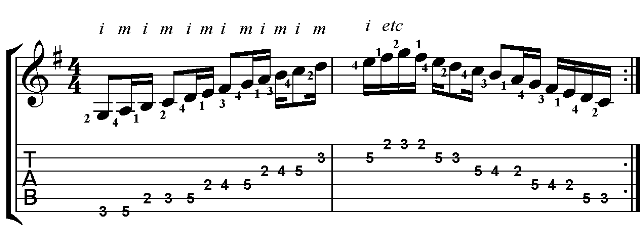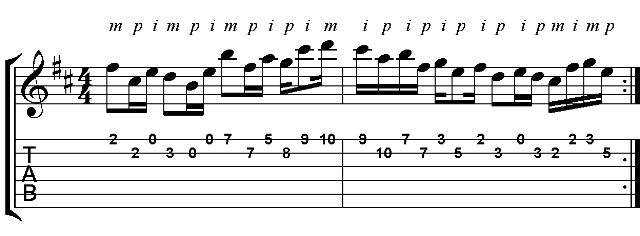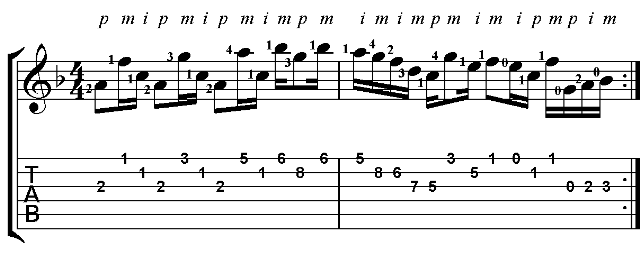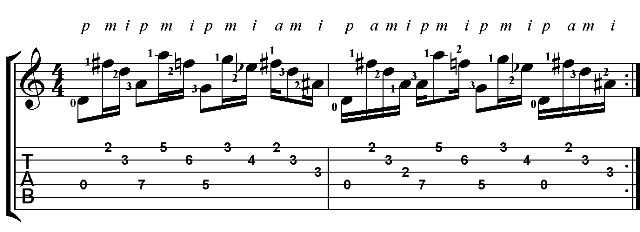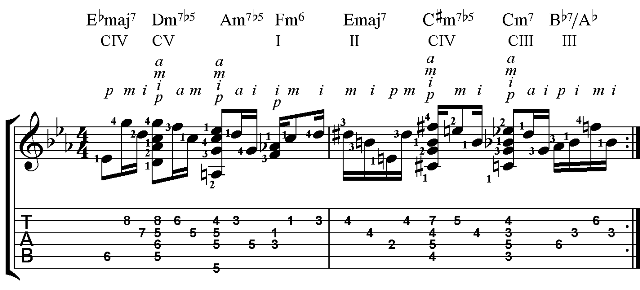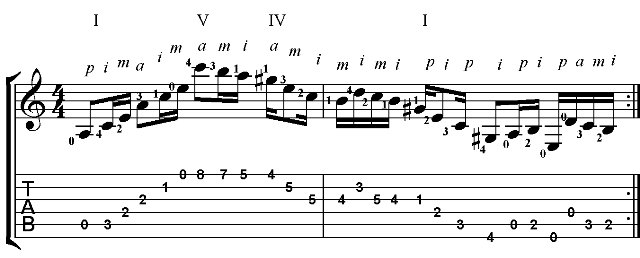Many books, teachers, and students devote a great deal of time to developing the use of chords and scales, and almost entirely neglect the development of rhythmic skills. This is unfortunate, as guitarists in general, and those from a classical background in particular, often seem to have a weakness in this area.
The following exercises are intended to give some guidance on how I continue to address this problem in my own playing and that of my students.
Example 40: Rest and Free Stroke
EX.40 Play the following examples using the suggested right hand fingers using both rest and free stroke. Use a metronome, starting slowly and gradually increase the tempo until you reach around 120 bpm. Rather than being over concerned with speed, you should concentrate on articulating the notes with precision and on achieving a good, solid tone. Repeat each example over and over again until it can be played without any feeling of hesitation or strain.
The following example takes the same rhythm, and applies it to an ascending and descending ‘E shape’ G Major scale. Practice the same pattern, using all of the suggested right hand fingerings.
Now use the same approach with the other four CAGED Major scale fingerings. Once you have done this, you might try adapting these scales to include all of their associated modes, along with the twelve harmonic and melodic minor scales, and their modes as well.
I have only shown four out of many possible right hand variations. Once you get the hang of these, I suggest that you try some of your own. You might also try accenting one or two selected notes to develop individual finger independence and to add rhythmic variety.
Practising in this way facilitates the transformation of scales, (what we might regard as the ‘raw materials’, or ‘building blocks’ of music) into actual music. This approach works just as well with arpeggios and, as shown in the following exercises, with intervals and chords as well.
Example 41: First String
EX.41 Takes the same rhythm as Ex.40 and applies it to two melodic scale patterns, from two different keys, on the first string. I have indicated only one of the suggested right hand fingerings for each example but you should play both examples using at least some of the other alternatives.
You could also try inventing your own variations to work with. I suggest that you write them out and memorise them, so that you can concentrate on placing them accurately against the metronome without the added complication of wondering about what comes next. The idea here is to internalise these ideas to the point when you are able to unconsciously recall them when improvising, using them as frameworks on which to structure new phrases and variations.
Close study of the music of all great improvisers reveals that they often utilise favourite musical patterns and gestures, which are adapted to the needs of the moment through transposition, rhythmic metamorphosis, etc. It would be wrong to imagine that the use of these ‘signature licks’, or patterns, detracts from the originality or inventiveness of the musician in question, as they are an essential, part of their own unique, personal voice.
Example 42: First Two Strings
EX.42 takes these examples a stage further. I have retained the same rhythmic pattern as before but this time I have distributed the notes across the first two strings.
This example uses a combination of right hand fingering patterns derived from Ex.40 and 41. I hope that you can now begin to appreciate the need for the wide variety of fingering patterns suggested in these exercises. What we are trying to achieve is the ability to use any combination of right hand fingers, across any combination of strings, in a spontaneous and uninhibited manner. We need to develop this technique to the point that we can respond automatically to our musical ideas, as they arise.
Example 43: Strings One, Two, and Three
EX.43 again takes the same rhythmic pattern, but this time applies across strings one, two and three.
Example 44: Strings One, Two, Three, and Four
EX.44 applies it across the first four strings.
Example 45: Five Strings
EX.45 shows the same rhythmic pattern across the first five strings. (This example is in more of a Jazz style. I have included the chord symbols to show as clearly as possible, the relationship between the CAGED chord shapes, the pre-determined rhythm, and the resulting melody.)
Example 46: All Six
EX.46 and finally across all six strings.
Video: For Turiya
The above lesson is taken from my book: ‘Improvisation for ‘Classical, Fingerstyle, and Jazz Guitar’, which is available from Amazon, Google Books, and other leading retailers. I hope it helps in developing your rhythm and guitar skills the same way it has helped mine and my students’.
Paul
Excerpt from Paul Costello’s ‘Improvisation for ‘Classical, Fingerstyle, and Jazz Guitar’






